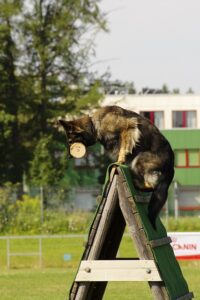German Shepherds, or GSDs, are a beloved breed known for their intelligence, loyalty, and versatility. Yet, within this imposing breed, there exist two distinct categories that are often misunderstood by the general public: Working Line vs Show Line German Shepherd. This blog post explores the subtle and sometimes not-so-subtle differences between the two, helping enthusiasts, owners, and would-be owners understand what makes each line unique.
Understanding the lineage of your German Shepherd is crucial, as it directly impacts factors such as temperament, health, and overall suitability for different lifestyles. We will introduce, differentiate, and dissect these lines to shed light on essential considerations for anyone fascinated by this remarkable breed.
Table of Contents
What Defines Working and Show Lines?
The distinction between Working Line and Show Line German Shepherds is multifaceted. While both lines are German Shepherds at their core, they have been bred with different purposes in mind, leading to distinct characteristics.
Working Line
Working Lines are focused on traits that make an excellent service or utility dog. These systems include the military, police, search and rescue, and various other jobs where the dog’s skill and intelligence are called into action. They are often bred for their drives, including prey, defense, and pack drive, and are usually more energetic and intense than their show line counterparts. Their physical structure is optimized for function, with a straighter back and a more athletic build.
Show Line
The breeding of Show Line GSDs centers around appearance and conformation to the breed standard. This line produces dogs often seen in the show ring, characterized by their striking appearance, fluid movements, and anatomical correctness. The emphasis on looks can sometimes lead to exaggerated physical features, such as a more sloped back and a fuller coat. Show Line GSDs are generally more laid back and less energetic, as their temperament is not as high-strung as Working Lines.
8 Key Considerations for Prospective Owners
Deciding between a Working Line and a Show Line GSD requires careful examination of various facets to ensure the dog’s traits align with the owner’s needs and capabilities.
I. Temperament and Behavior
Temperament is arguably the most critical aspect to consider when choosing a dog. Working Lines tend to be more high-energy, intense, and focused, with an innate desire to work and achieve goals. Alternatively, Show Lines are more relaxed and sometimes described as “softer,” with a lower energy level and a tendency to bond deeply with their family but are often less driven to work.
II. Physical and Health
Both working and show lines can be susceptible to certain hereditary health issues, but in different frequencies. For example, Show Lines are more prone to hip and elbow issues due to their conformation, while the Working Line’s straighter back may mean they are less likely to inherit these specific problems.
III. Grooming and Maintenance
The grooming demands of Working and Show Lines can be quite distinct. Show Lines with their luxurious, heavier coat require more frequent brushing and attention to maintain coat health and appearance, while Working Lines’ shorter coat is more manageable with a regular brushing schedule.
IV. Activity Level and Exercise
The high-energy Working Line GSD needs plenty of stimulation and exercise to stay happy and healthy. These dogs are the ideal companions for an active lifestyle with regular, vigorous exercise requirements. Show Lines still need activity but generally in slightly lower quantities compared to their working cousins.
V. Training and Intelligence
German Shepherds are renowned for their intelligence and trainability, irrespective of their lineage. Working Line dogs may have a slight edge in terms of their drive to work and ability to quickly learn tasks related to their specialized roles. Show Lines, however, excel in obedience and are adept at learning a variety of commands and activities.
VI. Suitability for Different Roles
While both lines can be excellent family pets, each is better suited to certain roles. For example, a Working Line GSD could be an exceptional jogging companion or a successful competitor in dog sports. Conversely, Show Lines may be better suited for the role of a therapy dog or a loyal family protector.
VII. Drive Baby Drive
Working line German Shepherds are bred to have high drive. The roles for which they are bred are functional, not aesthetic. Whether they end up as police or military dogs, with handlers whose main purpose in getting them is to compete in dog sports like Schutzhund, with trainers who train high level personal protection dogs or in a home with a dedicated owner, these dogs have drive. You may find a show line German Shepherd couch potato happy to sit on the couch and watch TV but it would be rare to find that in a working line German Shepherd.
VIII. Breeder Selection
The importance of selecting a reputable breeder cannot be overstated. A good breeder will be able to provide information on the lineage of their dogs, any genetic health testing that has been performed, and the environment in which the dogs were raised. It is imperative to choose a breeder who is knowledgeable and passionate about their line, and will steer you to the dog best for your needs. If it turns out that is not their high drive line, they’d rather lose the sale than place a dog in the wrong setting.
The Debate: Working Line vs Show Line
Despite the apparent differences, the debate rages on about which line is ‘better.’ We’ll explore some of the common misconceptions and why individual assessment is more valuable than blanket judgments.
Every Dog is an Individual
You can make some assumptions based on the breeding of a dog, but there are always outliers who won’t fit the mold. This is where meeting both the parents of the puppy and having a look at the puppy before you choose are important. I met, my GSD Jaspers, parents and saw him at 6 weeks to pick him from his litter. Of the three sable males I looked at Jasper was the one that seemed to enjoy being held and petted more than either of his brothers. All three were social and outgoing, but Jasper snuggled. He still does!
Puppy Personality is not Fully Formed
A puppy’s personality is not fully formed but you can judge some traits. Trainers picking puppies for competition or personal protection will look at how the puppy reacts to a new room and new stimulations, such as sudden noise. They want a dog with a “harder’ constitution. Jasper, despite being working line, is a “softer” dog. He has an innately sweet nature, except around other dogs. Still, he is being trained for protection. It does not take much for a 90 pound dog to convince someone to pick an easier target. Protection training is a game to the dog, and it’s a game Japer enjoys. Some dogs like to bite and are valued in the sports ring for that trait, which is channeled with intense training. Jasper likes to play the game. Even so, when he is playing the game, he is convincing.
Beauty is Primary
In the show line dogs, what is looked for is beauty and confirmation to breed standard. Because this is what they are bred for, other characteristics that were considered foundational to the breed such as courage and steady nerves, are sometimes not there. Also in American show lines, a desire for the pronounced angulation of the back legs has been criticized as making the dog more likely to have orthopedic issues. Overall, show line German Shepherds will be less driven, but they are still German Shepherds with the traits the breed was bred for. Just less driven.
Conclusion
German Shepherds are as diverse as they are beloved. They offer a spectrum of qualities, and whether you opt for a Working Line or a Show Line, what is most crucial is the time, care, and love you put into your bond with them. Choosing the right line for your lifestyle and expectations, and maintaining them with responsible ownership practices, will ensure a fulfilling life for both you and your GSD.
The Working Line vs Show Line debate isn’t about which is superior, but which is the best fit for you. It’s a decision that requires careful consideration, but one that, when approached with an open mind and the right information, can lead to a fulfilling canine-human partnership.

